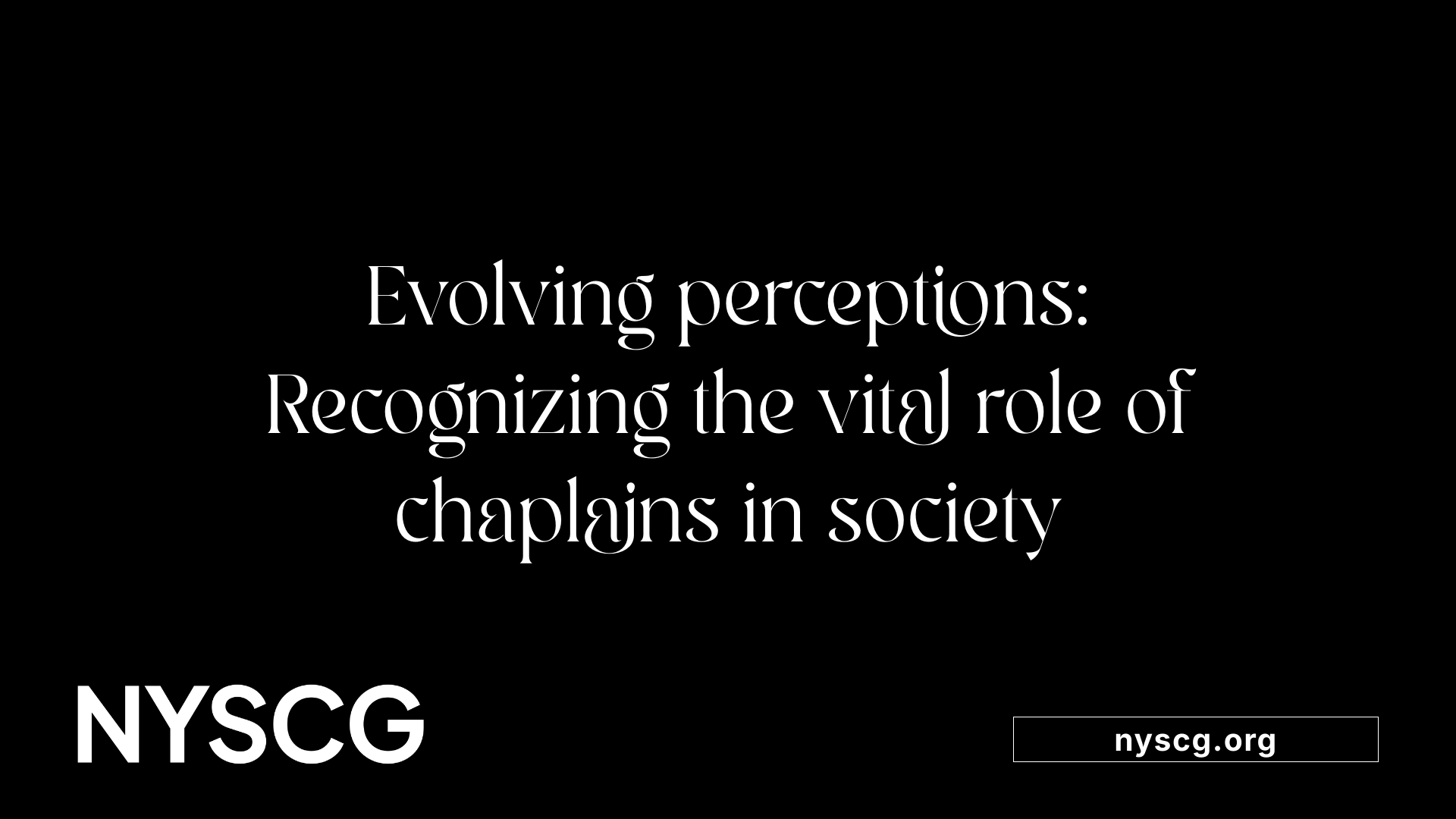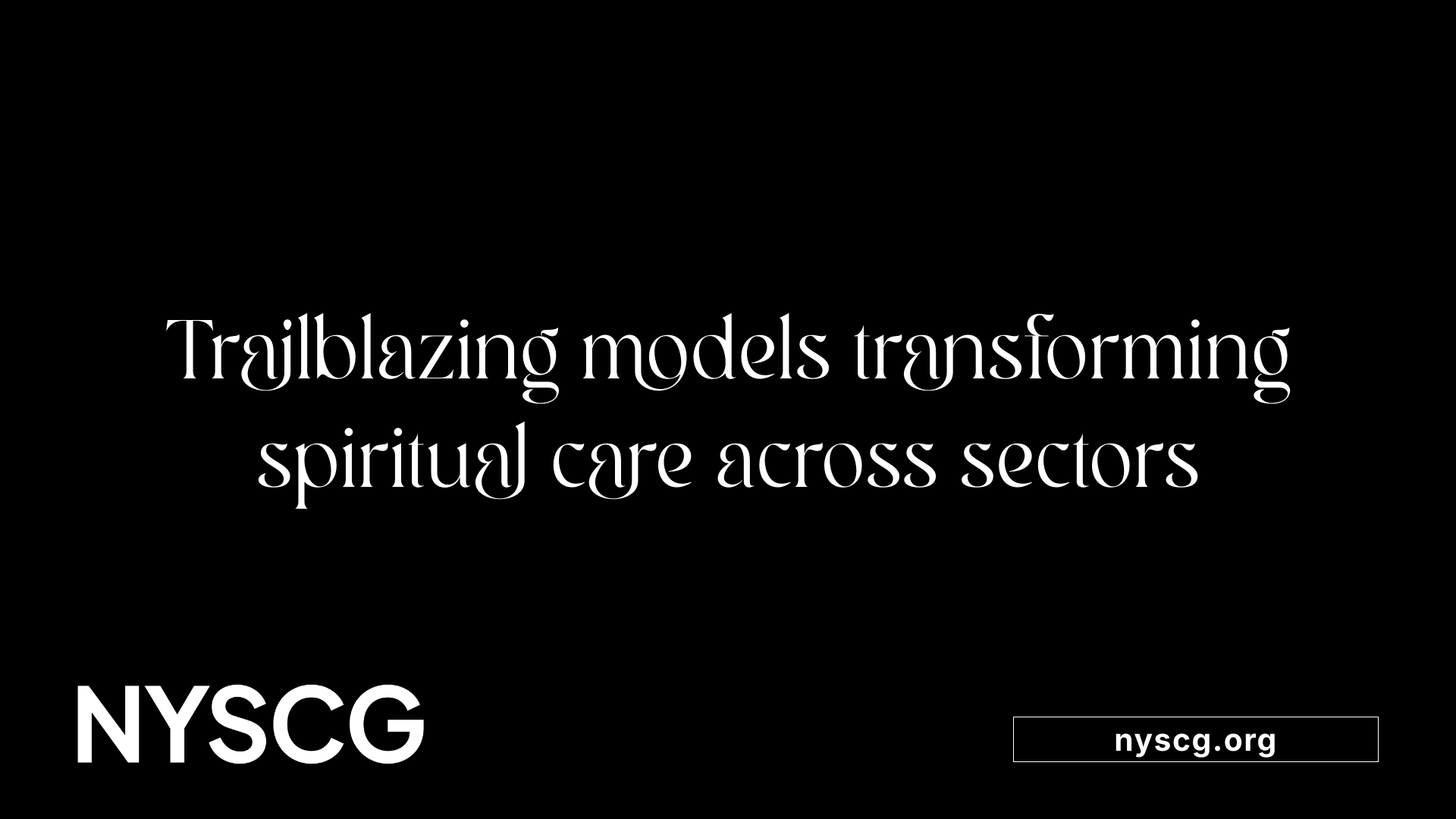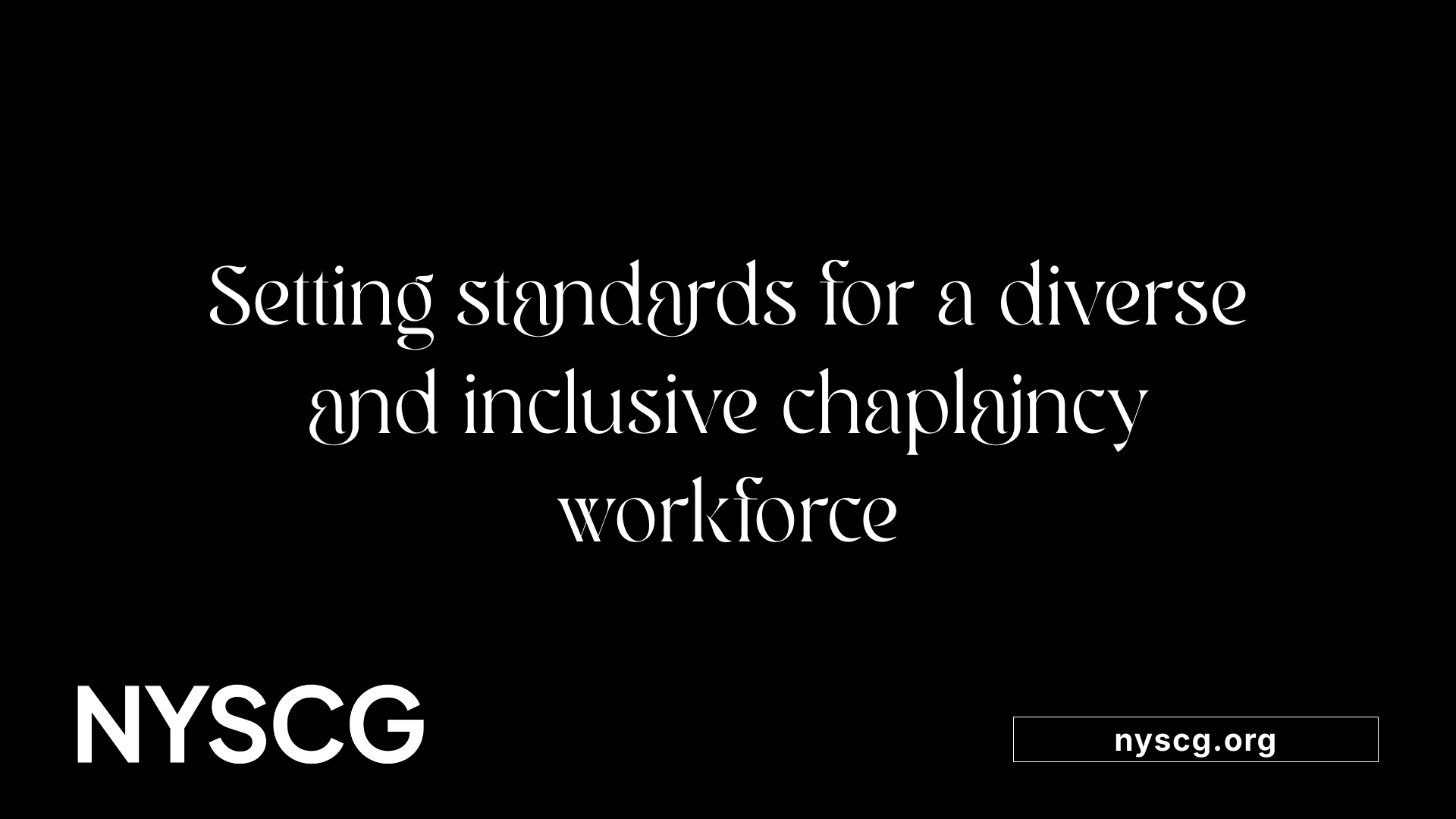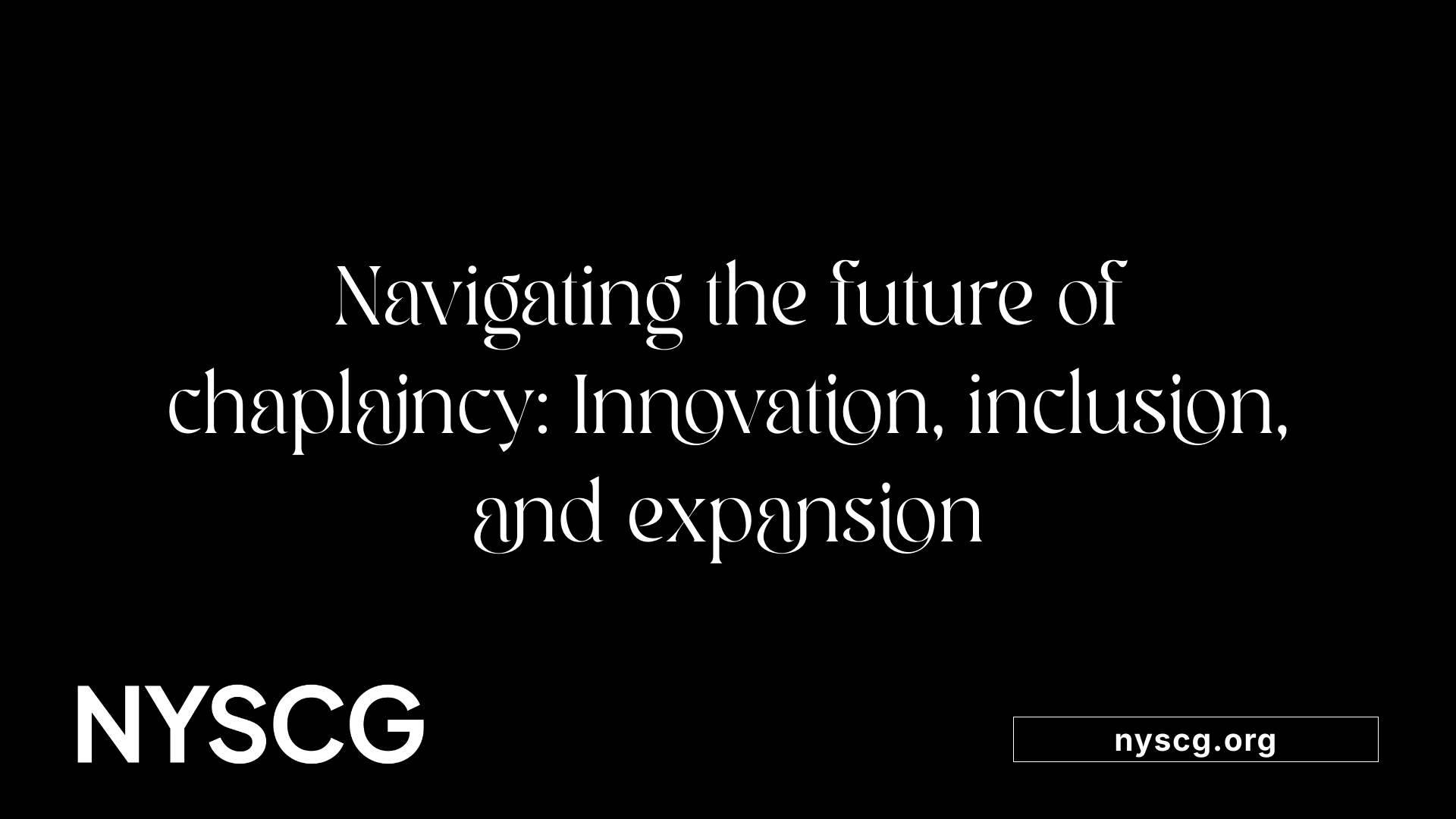How Is Chaplaincy Evolving in Today’s Society?


Chaplaincy, traditionally rooted in religious communities, is experiencing significant transformation. This evolution reflects societal changes, increased diversity, and a broader recognition of the need for holistic emotional and spiritual support across various sectors. Today's chaplains are vital allies in healthcare, correctional facilities, military, and community services, adapting their roles to meet the complex and pluralistic spiritual landscape of contemporary society.
The role of chaplains has broadened significantly over recent years, moving beyond traditional religious institutions to serve in a wide range of environments including healthcare, military, correctional facilities, and community settings.
In healthcare, chaplains are integral members of interdisciplinary teams. They offer emotional and spiritual support to patients, families, and staff, helping to reduce stress, improve communication, and support holistic healing. Their involvement enhances patient satisfaction and can contribute to better health outcomes, such as decreasing ICU stays and emergency costs.
In the military, chaplains support service members and their families, providing spiritual guidance during deployment, recovery, and loss. They often hold ranks such as captain and receive specialized military training to address the unique challenges faced by active-duty personnel.
Correctional chaplains now operate mostly under a clinical model, focusing on therapeutic support, substance abuse treatment, and moral guidance. They work to reduce recidivism by fostering individual expression of spirituality and providing a non-judgmental, supportive environment.
Community-based chaplains serve diverse populations and are involved in social justice, mental health, and outreach initiatives. Their roles are expanding to include advocacy, conflict resolution, and cultural mediation, especially as society becomes more diverse and increasingly secular.
Modern chaplains frequently collaborate with healthcare professionals, social workers, and community leaders. They serve as cultural mediators, helping bridge religious, spiritual, and secular perspectives.
In hospitals, they participate in rounds, assist with complex communication, and help craft care plans that include emotional and spiritual elements.
In correctional settings, they coordinate with mental health and social services, employing therapeutic community models that have been shown to reduce recidivism.
This integration facilitates a comprehensive approach to care, emphasizing mental well-being alongside physical health.
Chaplains provide support not only to patients and their families but also to healthcare staff, security personnel, and first responders. During crises such as the COVID-19 pandemic, their presence has been crucial in reducing burnout and moral distress among caregivers.
The benefits of expanded chaplaincy roles are evident in multiple outcomes:
| Setting | Support Provided | Positive Impacts |
|---|---|---|
| Healthcare | Emotional counseling, family communication, grief support | Increased patient satisfaction, improved team communication, reduced stress |
| Military | Deployment support, grief counseling, spiritual guidance | Resilience, reduced mental health issues, morale boosting |
| Corrections | Substance abuse therapy, moral support, conflict mediation | Recidivism reduction, personal growth, improved inmate behavior |
| Community | Social justice advocacy, mental health support | Enhanced community cohesion, empowerment of marginalized individuals |
As societal needs evolve, the roles of chaplains continue to expand, reflecting their importance in fostering resilience, providing inclusive spiritual care, and strengthening community and organizational health.

The way society views chaplaincy has significantly evolved over recent decades. Traditionally, chaplains were seen mainly as religious figures serving specific faith communities within institutions like churches, hospitals, and military establishments. Their primary role was often viewed through the lens of religious rituals and denominational support.
However, in recent years, this perception has expanded. Today, society recognizes chaplains as versatile providers of inclusive, holistic spiritual and emotional care for all individuals, regardless of faith or belief system. This shift reflects broader societal changes, including increased awareness of mental health, wellness, and the importance of addressing emotional needs.
Chaplains are now regarded as integral members of interdisciplinary teams within healthcare and social services. They serve not only as representatives of faith but as facilitators, educators, and emotional support providers. Their roles have become more fluid, accommodating diverse beliefs, including secular humanism and atheism.
This transformation is driven by societal shifts such as the decline in traditional church attendance and the rise in religious disaffiliation. About 28% of Americans identify as religiously unaffiliated as of 2024, which underscores the need for spiritual care providers capable of serving people of varied backgrounds.
The increased public and institutional recognition of the benefits of spiritual care has also contributed to societal perception. Organizations and policymakers now see chaplains as vital in improving patient satisfaction, reducing stress, and fostering hope in contexts like healthcare, prisons, the military, and community settings.
Overall, the societal view of chaplaincy has transitioned from a narrowly religious role to a broad-based, inclusive profession that addresses the diverse spiritual and emotional needs of society's changing demographics.

Chaplains are becoming an integral part of healthcare systems by providing emotional, spiritual, and interpersonal support to patients and their families. They assist individuals facing serious illness, grief, or uncertainty, helping them find purpose and hope amidst challenging circumstances.
In hospitals, chaplains are involved in real-time stress reduction, debriefing after critical events, and facilitating communication between patients, families, and medical teams. They support compassionate conversations about end-of-life decisions, including organ donation, through programs like the Family Communication Coordinator, which reduces stress and role ambiguity for clinical staff.
Chaplains also work with patients in diverse spiritual and belief backgrounds, ensuring that care is respectful and inclusive. Their presence often improves patient satisfaction, enhances communication, and contributes to a holistic healing process.
Beyond patient support, chaplains play a vital role in promoting staff well-being. Healthcare workers, including security and community health workers, often face high stress and emotional fatigue.
Chaplains provide a confidential space for staff to process their experiences, offering counseling, emotional outlets, and resilience-building strategies. During crises like the COVID-19 pandemic, interactions with chaplains increased notably, offering relief and moral support to overwhelmed healthcare personnel.
In addition, chaplains help create a supportive workplace environment, fostering teamwork and addressing emotional needs that can otherwise lead to burnout.
Many healthcare organizations now recognize the importance of spiritual care in mental health. Chaplains support mental health programs by addressing existential concerns, fostering hope, and providing a sense of connection.
They facilitate sessions that help patients and staff cope with trauma, loss, and anxiety. Their skills in active listening and empathy are instrumental in helping individuals process complex emotions, improving overall mental health outcomes.
Some programs include chaplains as part of multidisciplinary teams in mental health facilities, integrating spiritual support with psychological treatments.
Training for healthcare professionals increasingly emphasizes understanding spiritual and emotional needs. Many institutions offer education about the role of chaplains, how to collaborate effectively, and basic skills in providing spiritual support.
Chaplains themselves typically hold graduate education, clinical training, and often certifications in pastoral care. They serve as educators, teaching other caregivers about spiritual assessment, cultural competence, and ethical considerations.
Such training ensures that all healthcare workers can recognize when spiritual care might benefit their patients and how to work effectively with chaplains to meet diverse needs.
Yes, there are non-religious or secular chaplains who serve individuals of diverse beliefs, including atheists, agnostics, and humanists. Their roles have expanded significantly beyond traditional religious contexts, providing support tailored to secular values and moral perspectives.
These chaplains often draw on humanism, ethics, and a sense of wonder rather than supernatural beliefs. They facilitate rituals and support that respect individual belief systems, making spiritual care more inclusive.
The growth of secular chaplaincy aligns with increasing numbers of Americans identifying as religiously unaffiliated—about 28% as of 2024—and the recognition of nonreligious identities. Despite some institutional barriers and misperceptions, non-religious chaplains are gaining acceptance as vital providers of holistic spiritual and emotional support.
| Aspect | Traditional Chaplaincy | Secular Chaplaincy |
|---|---|---|
| Belief Focus | Religious/spiritual beliefs | Ethical, moral, humanistic values |
| Settings | Hospitals, military, prisons, education | Hospitals, community, institutions, digital platforms |
| Client Base | Usually faith-based individuals | Diverse beliefs, including non-religious |
| Role | Ritual support, prayer, faith-based counseling | Supportive dialogue, rituals based on individual values |
This evolution in chaplaincy demonstrates a broader societal move towards inclusivity and acknowledgment that spiritual well-being transcends traditional religious boundaries, addressing the needs of all individuals in a complex, pluralistic society.
The education and methods used by chaplains have seen significant evolution to meet the dynamic needs of society. Previously rooted mainly in religious traditions, training now emphasizes cultural awareness, diversity, and secular support techniques. This diversification allows chaplains to serve individuals from a broad spectrum of beliefs and backgrounds.
Chaplains typically undergo comprehensive educational programs, often requiring a master's degree in theology, ministry, or related fields. This academic foundation is complemented by supervised clinical training in settings such as hospitals, prisons, or the military. Continuous professional development ensures that chaplains stay current with societal shifts, emerging health challenges, and the nuanced needs of those they serve.
A key adaptation has been the integration of cultural competence into training curricula. Chaplains are equipped to navigate complex identities, religious pluralism, and secular perspectives. Diversity training emphasizes respect, active listening, and the ability to support individuals regardless of religious affiliation or non-affiliation.
In healthcare environments, chaplains now adopt an interdenominational and inclusive approach, focusing on virtues and spiritual well-being without proselytizing. They facilitate communication among medical staff, patients, and families, tailoring interventions based on culturally sensitive assessments.
Record-keeping and documentation practices have become standard, supporting accurate communication within interdisciplinary teams and ensuring that spiritual care is aligned with overall treatment goals. These practices help normalize chaplaincy as a professional, integral part of holistic care teams.
Moreover, societal shifts toward pluralism and secularism have prompted chaplains to incorporate non-religious support methods. For example, secular humanist and atheist chaplains now serve alongside traditional faith-based counterparts, broadening the scope of spiritual care.
In summary, the training and practices of chaplains have evolved to be more inclusive, culturally aware, and integrated within formal health and social systems. These changes foster a more accessible and relevant form of spiritual and emotional support, aligned with societal realities and diverse belief systems.
As societies become more diverse, chaplaincy services are experiencing profound changes to meet the evolving spiritual and emotional needs of varied communities. This shift requires chaplains to develop a high level of cultural sensitivity and competence. Traditional models that focused primarily on Christian-centered care are expanding to incorporate multiple faiths, spiritual practices, and secular worldviews.
With a growing number of individuals identifying as religiously unaffiliated—including about 28% of Americans as of 2024—chaplains must be adaptable. Support extends beyond conventional religious rituals to include secular humanism, atheism, agnosticism, and other belief systems. Chaplains now serve as facilitators of open dialogue, helping individuals find meaning and resilience regardless of religious affiliation.
Efforts to diversify the chaplain workforce aim to better reflect the communities they serve. Educational institutions increasingly offer programs that include chaplains from various religious backgrounds and secular philosophies. Collaborative training and certifications, such as those provided by Global University or secular organizations like the Humanist Society, promote inclusivity.
In practice, cultural competence involves respectful understanding of different traditions, avoiding cultural appropriation, and fostering trust through genuine engagement. Chaplains are trained to recognize their own biases and to approach each individual’s spiritual or existential journey with openness and respect.
This inclusive approach contributes to a more just and equitable healthcare environment. It also enhances the effectiveness of spiritual support, leading to higher patient and staff satisfaction and improved health outcomes.
| Aspect | Traditional Focus | Evolved Approach | Impact on Service Delivery |
|---|---|---|---|
| Faith Representation | Mainly Christian | Multi-faith, secular, nonreligious | Broader support options, inclusivity |
| Workforce Diversity | Mostly white, male, Christian | Growing inclusion of diverse backgrounds | Better community reflection, cultural competence |
| Training Programs | Focused on denominational training | Interfaith and secular certification | More relevant, adaptable skill set |
| Client Demographics | Community members involved in religious institutions | Individuals of varied beliefs, including no faith | Increased accessibility and trust |
| Support Practices | Religious rituals and prayers | Respectful engagement with beliefs, existential conversations | Personalized, respectful care |
Societal shifts continue to shape a more inclusive chaplaincy landscape, fostering an environment where all individuals, regardless of their cultural or spiritual identity, can find meaningful support. As this field evolves, ongoing education, workforce diversification, and cultural competence remain pivotal in delivering care that honors human dignity and promotes healing across diverse communities.

Chaplaincy is experiencing a wave of innovative service models that expand its reach beyond traditional roles. In educational environments, new approaches like the 'Bridge Builder' and 'Holy Jo/E' models are being implemented. These models foster active community involvement, offer a consistent spiritual presence, and support mental health, enabling chaplains to connect with students and staff in meaningful ways.
In healthcare settings, flexible staffing strategies are transforming how spiritual care is delivered. Cross-training chaplains, sharing roles across departments, and creating specialized positions for particular care lines help meet the diverse needs of patients, families, and staff. These strategies aim to improve continuity, reduce gaps in service, and adapt to changing healthcare dynamics.
Outpatient and community-based services are also on the rise. Collaborations with local parishes, wellness initiatives, and outreach programs are designed to extend spiritual support into neighborhoods and community centers. Although organizations face challenges in full integration—such as funding constraints and establishing referral pathways—these efforts aim to make chaplaincy more accessible and relevant.
The diversification of chaplain roles continues, with new settings emerging such as the military, correctional facilities, social movements, and the corporate sector. Digital technologies are playing a significant role, enabling virtual chaplaincy through online platforms, subscription-based models, and mobile apps. These digital modalities help reach a broader audience, especially those who may not seek traditional religious services.
The future of chaplaincy is also marked by a focus on sustainability and inclusivity. Developing business models that balance financial viability with service quality is vital. Fostering broad coalitions across religious, spiritual, and secular communities increases public awareness and acceptance. This collaborative approach ensures that diverse spiritual needs are met, respecting individual beliefs and identities.
Overall, the landscape of chaplaincy is shifting rapidly, driven by societal change, technological advances, and a commitment to serving communities of all backgrounds. The innovative models emerging today are laying the groundwork for a more adaptable, inclusive, and effective form of spiritual care.

As societal diversity continues to grow, chaplaincy services are undergoing significant changes to meet the varied spiritual and emotional needs of increasingly multicultural communities. Chaplains now work in a landscape where understanding and respecting a broad spectrum of faiths, secular beliefs, and cultural backgrounds is vital.
To serve diverse populations effectively, chaplains must develop cultural competence — the ability to interact effectively with people across different cultures, religions, and worldviews. This often involves ongoing education and training to understand different spiritual traditions, practices, and values.
Many organizations are actively working to diversify their chaplain workforce by collaborating with educational institutions that serve various cultural and faith communities. This strategy helps to ensure that chaplaincy teams better reflect the demographics of the populations they serve. It enables the delivery of more personalized, respectful, and relevant spiritual care.
Cultural sensitivity is essential to prevent misunderstandings or inadvertent disrespect. Practices such as respectful cultural appreciation and awareness of potential cultural appropriation are emphasized to foster trust and safety.
The shift towards a more inclusive approach also pushes the field to adopt interfaith and secular models of care. Chaplains trained to support individuals regardless of faith tradition can better serve patients, families, and communities that encompass a diversity of spiritual experiences.
This evolution in chaplaincy promotes values of justice, dignity, and respect, supporting societal ideals of inclusivity. By embracing diversity, chaplains help create environments where all individuals feel valued and understood, thus improving overall well-being and fostering a sense of belonging.
Standardized certification and credentialing processes are advancing to ensure that chaplains possess the necessary skills to serve diverse populations effectively. Certification bodies often require specific educational backgrounds, clinical training, and endorsement from recognized faith or secular belief groups.
Quality assurance measures, including ongoing professional development and adherence to best practices, are integral to maintaining high standards of care. These include participation in interprofessional education, where chaplains collaborate with healthcare providers, social workers, and other professionals to deliver holistic support.
Educational programs increasingly emphasize interdisciplinary learning, preparing chaplains to work seamlessly within complex care teams. Topics such as ethical considerations, cultural competency, and evidence-based practices are prioritized to enhance collaboration.
Credentialing processes vary widely; however, a common requirement involves obtaining a master’s degree in theology, religious studies, or related fields, along with clinical pastoral education units. There is a growing recognition of secular and humanist chaplains, who meet standards set by organizations like the Humanist Society and other secular endorsement bodies.
| Aspect | Standards & Practices | Supporting Organizations | Notes |
|---|---|---|---|
| Certification | Graduate degree, clinical training, endorsement | Association for Clinical Pastoral Education (ACPE), Board of Chaplains Accreditation | Includes secular and religious chaplains |
| Quality Assurance | Continuing education, peer review | Joint Commission, healthcare systems | Focus on inclusivity and cultural competence |
| Interprofessional Education | Collaborative training modules | Healthcare institutions, universities | Enhances team-based care |
| Credentialing | Varies by faith or secular affiliation | Humanist Society, Religious Endorsement Bodies | Meets societal and occupational standards |
The trend towards increasing diversity has spurred the development of chaplaincy programs that are more inclusive, culturally responsive, and capable of serving a wide array of spiritual needs. These developments ensure that spiritual care remains relevant and accessible to all sectors of society, fostering healing, understanding, and respect across cultural boundaries.

The field of chaplaincy is experiencing rapid evolution, with new models and broader areas of service appearing across various sectors. In educational settings, innovative approaches such as the 'Bridge Builder' and 'Holy Jo/E' models aim to foster community involvement, spiritual presence, and mental health support. These models focus on creating inclusive environments that serve diverse student populations and staff, promoting well-being beyond traditional religious boundaries.
In healthcare, staffing strategies are becoming more flexible. Cross-training, shared chaplaincy roles, and specialized positions for specific care lines help meet changing demands and enhance care continuity. These adaptations allow chaplains to work more effectively alongside medical teams, addressing emotional and spiritual needs during critical moments.
Outpatient and community-based services are also expanding. Collaborations with local churches, wellness initiatives, and outreach programs extend spiritual support into neighborhoods and local organizations. Although integration challenges remain, these efforts aim to reach more people outside traditional settings, particularly those who may not participate in organized religion.
Furthermore, chaplaincy is broadening its presence into unconventional environments such as military installations, correctional facilities, social justice movements, and corporate sectors. The adoption of digital platforms—webinars, virtual counseling, and subscription-based spiritual programs—reflects the field’s push toward accessible, scalable support services.
Overall, there is a strong emphasis on creating sustainable business models for chaplaincy, increasing public awareness of its value, and forming coalitions that cross religious and secular boundaries. These developments are vital for addressing the diverse spiritual care needs of a society that is becoming more pluralistic and interconnected.
Despite these promising developments, institutional barriers such as inconsistent standards, limited recognition, and funding challenges persist. Many organizations lack clear policies supporting chaplaincy integration, hindering consistent service delivery.
Efforts to improve public awareness are crucial. Increasing understanding of the expanded roles chaplains play—including emotional support, mental health facilitation, and community outreach—can help reduce misconceptions. Campaigns, media engagement, and educational initiatives aimed at both healthcare providers and the public are vital.
Strengthening advocacy efforts is essential to establish unified standards and accreditation processes for chaplaincy programs. Developing comprehensive policies can ensure quality, professionalism, and equitable access across sectors.
Concerted policy initiatives could also promote funding for chaplaincy services, recognizing their contribution to holistic well-being and system efficiency. Integrating spiritual care into broader health and social care policies will further legitimize and support chaplaincy endeavors.
To sum up, emerging models of service and expanding avenues offer exciting possibilities for the future of chaplaincy. Overcoming ongoing institutional barriers and raising public consciousness through advocacy and strategic policy-making will be instrumental in realizing this potential.
As societal values continue to shift towards inclusivity, mental health awareness, and holistic well-being, chaplaincy is becoming more vital than ever. The profession's evolution reflects a commitment to serve diverse populations with compassion, competence, and cultural sensitivity. Embracing innovative models, standardized training, and expanded roles, chaplains are poised to remain integral to health, justice, education, and community sectors. Their ability to adapt to changing societal needs ensures that spiritual care remains a meaningful, accessible, and respected facet of public life, fostering resilience, dignity, and hope among all individuals in an increasingly complex world.
All you need is the will to make the world a better place.
New York State chaplain group inc. is a tax deductible organization with a federal tax Id number 92-383-4921